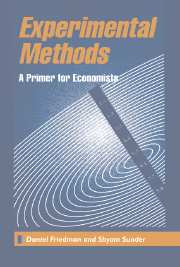Book contents
- Frontmatter
- Contents
- List of figures and tables
- Preface
- Acknowledgments
- EXPERIMENTAL METHODS
- 1 Introduction
- 2 Principles of economics experiments
- 3 Experimental design
- 4 Human Subjects
- 5 Laboratory facilities
- 6 Conducting an experiment
- 7 Data analysis
- 8 Reporting your results
- 9 The emergence of experimental economics
- Appendixes: Supplemental materials
- Glossary
- References
- Index
Preface
Published online by Cambridge University Press: 05 June 2012
- Frontmatter
- Contents
- List of figures and tables
- Preface
- Acknowledgments
- EXPERIMENTAL METHODS
- 1 Introduction
- 2 Principles of economics experiments
- 3 Experimental design
- 4 Human Subjects
- 5 Laboratory facilities
- 6 Conducting an experiment
- 7 Data analysis
- 8 Reporting your results
- 9 The emergence of experimental economics
- Appendixes: Supplemental materials
- Glossary
- References
- Index
Summary
Laboratory experiments have become an important source of data for economists. Hundreds of journal articles, dozens of surveys, and several books report what laboratory experiments have helped us discover about commodity and asset markets, industrial organization, committees and voting, laws and rules, inflation, individual choice, games, and many other institutions and phenomena.
Information on how to conduct experiments has not kept pace with economists' interest in this new method of gathering empirical evidence. The published literature focuses on substantive results and provides little guidance about how to do your own experiments, especially if you are trying something new. Most experimental economists have learned their craft through apprenticeship. There has been no readily accessible, selfcontained summary of experimental method and technique for students and researchers in economics. This primer is intended to bridge that gap.
In this primer, we take you through the entire process of conducting economic experiments. We touch on broad conceptual issues and discuss the basic principles, but we emphasize concrete procedures for successful experimentation. Picking an interesting and important problem, creating a laboratory environment, choosing and motivating subjects, designing and conducting experiments, collecting and analyzing the data, reporting the results – these are the key tasks. It is easy for beginners to make mistakes, at considerable cost in money, time, and effort. The purpose of this book is to help you lower these costs and increase your scientific returns.
Information
- Type
- Chapter
- Information
- Experimental MethodsA Primer for Economists, pp. xi - xiiPublisher: Cambridge University PressPrint publication year: 1994
